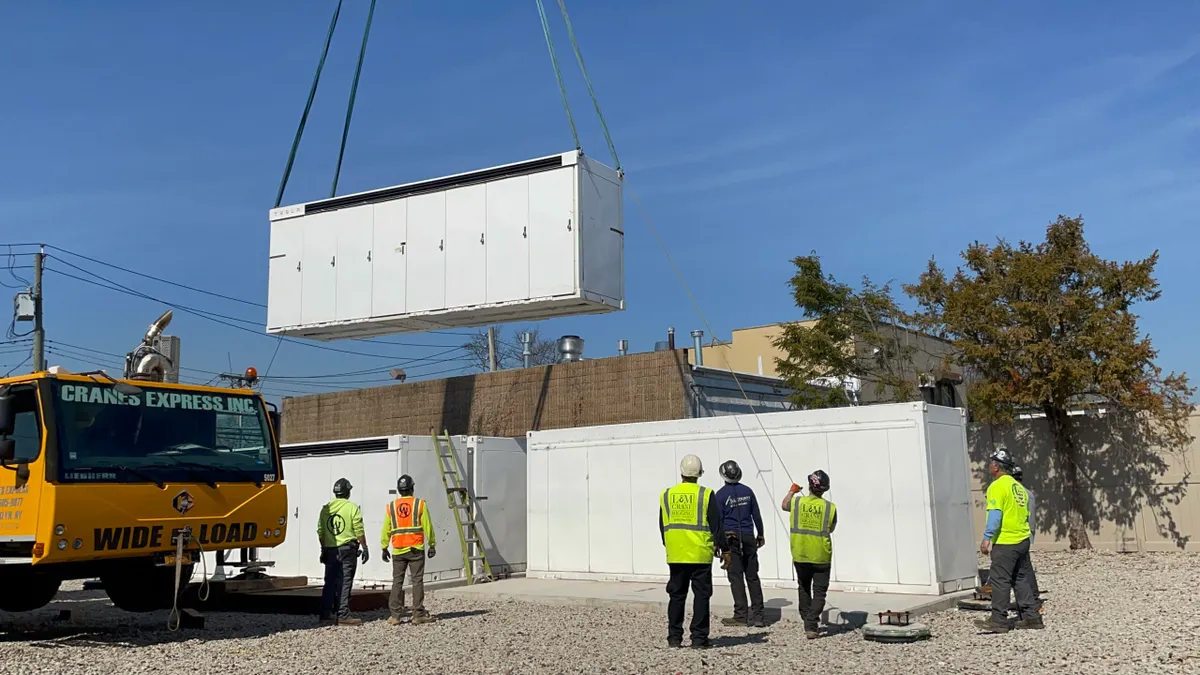The striking growth of electric vehicles (EVs) has been supported by policies intended to eliminate noxious emissions and transform the transportation sector.
A century after EVs fell out of the car market because gasoline-powered vehicles were cheaper to operate, forecasts show battery-powered transportation could take the market back because it is cleaner and becoming affordable. But controversial new research proposes revising EV policy because batteries degrade over time, increasing costs and emissions. EV experts say the research is incomplete and outdated.
"Battery sizes and lifespans are going up and grid emissions are going down as renewables penetrations increase," Chris Nelder, a mobility practice manager with think tank Rocky Mountain Institute (RMI), emailed Utility Dive. "Question all assumptions."
EVs and battery degradation
EVs will be 24% of U.S. light-vehicle fleet in 2030, according to "Predictive modeling of battery degradation and greenhouse gas emissions" from Case Western Reserve University researchers. They will be 33% of the global feet in 2040, according to Bloomberg New Energy Finance’s 2018 forecast, and 30%, according to BP’s 2018 forecast.
Transportation sector greenhouse gas (GHG) emissions were 28% of total U.S. GHGs in 2016 and cars and trucks were 83% of that, according to the Environmental Protection Agency (EPA). The EPA has targeted a 36.5% reduction in light duty vehicle fleet GHG emissions by 2025, the Case Western paper reports.
A range of federal, state, and local policies and incentives support that target and other more specific emissions reductions. The most prominent is a federal tax credit of up to $7,500 for the purchase of a zero-emissions vehicle.
Emissions from EVs vary with the power mixes on the grids charging them, according to a 2018 assessment by Union of Concerned Scientists (UCS) senior engineer David Reichmuth.
From 2016 EPA sub-grid data on U.S. power plants emissions, "75% of people now live in places where driving on electricity is cleaner than a 50 MPG gasoline car," UCS found. "Based on where people have already bought EVs, electric vehicles now have greenhouse gas emissions equal to an 80 MPG car, much lower than any gasoline-only car available."
The Case Western researchers studied state by state emissions and performance variations from the degradation of a 2013 Nissan Leaf 24 kWh lithium-manganese-oxide–graphite (LMO) battery pack. The model, however, can be used to evaluate other EVs, according to the paper. It assumed individual states’ 2012 grid power mixes. With degradation, internal resistance increases, and the charge-discharge cycle becomes significantly less efficient, it found.
The industry standard for a battery's full life is to 30% efficiency loss, according to the paper. Depending on variables, including the power mix of the grid, the climate where the vehicle is used, and the driving habits of the vehicle owner, "energy consumption and GHG emissions can be increased by 11.5% to 16.2%."
This finding should be considered in EV policymaking, the paper recommends. States with significant GHG reductions "should be provided with enhanced incentives" but "states with small or no GHG emission reductions should be provided with less or no incentives."
This proposal "could apply to the $7,500 tax credit," Associate Professor of Engineering and paper lead author Chris Yuan, who described himself as an EV advocate, emailed Utility Dive.
Focusing incentives based on current or past local emissions profiles is "a short-sighted view," UCS’s Reichmuth told Utility Dive. "That trades small or non-existent emission changes in the short term for the longer-term benefits of transformative change to low emission transportation."
Battery degradation and its impacts
EV batteries undergo a "complex degradation process" that involves two cycles, the Case Western paper reports.
One is the cycling capacity loss due to charging and discharging, which degrades the battery’s electrodes and causes lithium loss. The other is "calendar capacity loss," due to self-discharge and side reactions that occur as the battery’s state of charge, age, and ambient temperature changes.
State by state operating conditions cause varying battery degradations, and "temperature-induced calendar loss dominates battery degradation, particularly in the first year," the paper reports. The result is that "electricity consumption and GHG emissions in each state are largely different."
Hotter weather and increased driving also accelerate battery degradation by requiring more frequent recharging. The result is increased electricity consumption and increased GHG emissions that cause decreased driving range, decreased cycling efficiency, and earlier battery replacement.
"States with a high annual travel demand above 18,000 km and a high ambient temperature above 28°C in summer have more severe capacity losses," the researchers reported. Nationally, "battery life is ranging between 5.2 years in Florida and 13.3 years in Alaska."
The researchers tested their conclusions against different assumptions. Battery performance varied only 1% with a 40% increase in travel, and only 6% with a 20% increase in battery power. GHG emissions, however, fell "proportionally" to an increase in penetration of renewables in the grid power mix.
The findings could be used by EV battery designers to "improve the EV battery performance under different operation conditions," the paper suggests. Where ambient temperature is above 28°C, battery life can be significantly extended by "a temperature control system" for when the EV is not operating.
The findings could also be used to optimize "the scheduling of battery replacement, inventory planning, and control of the battery supply," the paper adds.
Case Western’s research was limited to the air-cooled 2013 Nissan Leaf 24 kWh LMO–graphite battery pack, the paper acknowledges. "The advancement of battery and vehicle technologies" and "different sizes and chemistries of the battery pack may affect the final results."
On the other hand, the advanced technologies that make fast-charging more accessible "could induce extra degradation," the paper notes. That would "increase the unit energy consumption and GHG emissions from the EV if being used on a regular basis."
Points of contention:
1. More batteries
Reichmuth, RMI’s Nelder, and Noah Barnes, spokesperson for advocacy group Plug In America (PIA), said the paper’s conclusions are significantly compromised by its focus on only one battery design.
"Battery degradation is important," Reichmuth said. "But this study was of an air-cooled battery. The Tesla and the Chevy Bolt have liquid-cooled batteries and that will make a difference on real world performance."
Data from PIA surveys of Tesla Roadster and Model S drivers found "no correlation between climate and battery capacity loss but Nissan Leaf drivers reported a correlation, Barnes said. "Battery life depends on many factors and there’s no inherent reason for batteries to degrade more quickly because of climate. Some may today, but we expect that to improve over time."
There are batteries with capacities ranging from 40 kWh to 100 kWh that will all have different degradation and performance profiles, Nelder added.
The research was limited to the one battery, Yuan agreed. "For other emerging batteries, we need to test their performance under different conditions to see how [degradation] will change."
2. The power mix
The power mix on the 2012 grid was far more fossil fuel-intensive than today’s grid and the trend is toward higher penetrations of emissions-free generation, the EV advocates agreed.
Modeling with newer data, as UCS did, "will definitely have an impact," Yuan said. But the change "is happening gradually" and the impact of updated grid data on the paper’s findings "will not be significant."
RMI’s Nelder sharply disagreed. The UCS results show that cleaner grids can make driving EVs the cleaner option. And "the share of coal-fired power in extra coal-heavy states should not be projected forward," he added. "Many of those plants are already on the chopping block."
More significantly, by switching from internal combustion engines (ICEs) to EVs, "you open a pathway for decarbonization of transportation via decarbonization of grid power," he added. "There is no such pathway if we stay on ICE vehicles."
3. State by state?
The paper’s state-level modeling is also problematic, Reichmuth said. "UCS used EPA sub-regions because the grid region power mixes don’t match state boundary lines. Many states get electricity from more than one system provider and some get electricity from other states."
The "bigger picture" is that, "over the last decade, coal has dropped from nearly 50% of the grid mix to 30% and utility-scale wind and solar are nearing 10%," he added. "It’s less important what the emissions of a Nissan LEAF in any one state were in 2012. What’s important is being able to make substantial reductions in transportation emissions in the coming decade."
Many factors besides the state-level grid mix affected the assessment, Yuan said. Future studies may offer more insight on variations at grid sub-regions.
Both Reichmuth and Barnes stressed that ICE vehicles’ emissions also go up in hotter states. "The higher the energy requirement for both vehicles, the more EVs save in GHG and cost," Barnes said.
4. The $7,500
Both Reichmuth and Barnes objected to the idea of calibrating the $7,500 tax credit according to local efficiencies and emissions. "Greenhouse gas emissions are a global problem, not a state-by-state problem, and every electric vehicle put into service benefits the planet," Barnes said.
"The federal government should make the incentive simpler and more accessible by making it a time-of-purchase rebate," he said. "It should not create more confusion by modifying incentives by state."
Accelerated battery degradation that leads to early replacement may not be the burden described in the paper, Reichmuth said.
"The second-life and recycling-remanufacturing market is in its infancy, since most EVs and EV batteries are less than five years old," Reichmuth said. "Pilots are beginning to show their potential."
"There does not seem to be any technical reason why batteries can't be reused."

David Reichmuth
Senior engineer, Union of Concerned Scientists
A BMW and Pacific Gas and Electric (PG&E) 2015-2016 test proved the effectiveness of used EV batteries and managed EV charging in demand response (DR). It included eight used BMW EV batteries, which provided 80% of the 19,500 kWh supplied to the PG&E system for 209 DR events over 18 months.
Earlier this year, Nissan began making remanufactured Leaf batteries available at about $2,850 in Japan, which is less than half the new battery cost of about $6,200, according to Inside EVs.
"Batteries will eventually degrade, but there will be options for remanufacturing or reusing them," Reichmuth said. "There does not seem to be any technical reason why batteries can't be reused."
It is too early in the development of EVs to put together the benefits of second life opportunities and the costs of battery degradation, he added. "If a car with a 300-mile range drops to 200 miles, that might serve the driver’s needs but if a 60-mile range drops to 40 miles, that might matter."
It is also not clear how second life uses and will affect lifecycle GHGs, Yuan said. His team’s current work may supply answers. Battery replacement will increase the "manufacturing GHGs" while second life opportunities "may further affect the overall lifecycle GHGs."
"This paper points out the importance of continuing to reduce emissions from the electricity sector and the need to consider total lifecycle emissions when designing EV policies," Reichmuth responded. "But for air quality and for GHGs, we need to move to cleaner transportation, and we can't wait for the power sector to be perfect, and we can't wait for EVs to be perfect."






















